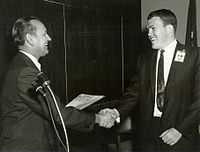Jack Garman

John R. "Jack" Garman is a computer engineer, former senior NASA executive and a noted key figure of the Apollo 11 lunar landing. As a young specialist on duty during the final descent stage on 20 July 1969 he dealt with a series of computer alarms which could have caused the mission to be aborted.
Early life
Garman was born in Oak Park, Illinois and attended the University of Michigan. He graduated in 1966 with a bachelor of science degree in engineering physics and a specialty in computing.
NASA career
In 1966 at the age of twenty-one Garman was hired by NASA. He chose to specialize in onboard computing and was assigned to the Apollo Guidance Program Section where he worked with MIT, supervising the design and testing of the Apollo Guidance Computer.
During the Apollo missions Garman worked in a support role, advising flight controllers in Mission Control on the operation of spacecraft computer systems. A few months before the Apollo 11 mission he suggested that simulation supervisors at Mission Control test how flight controllers might react to a computer error code. Guidance officer Steve Bales responded to the simulated error by calling an abort, which was found to be a needless reaction for that particular code. As Garman later recounted, "Gene Kranz, who was the real hero of that whole episode, said, 'No, no, no. I want you all to write down every single possible computer alarm that can possibly go wrong.'" Garman made a handwritten list of every computer alarm code that could occur along with the correct reaction to each of them and put it under the plexiglass on his desk.
1202

An error in procedural protocol went undetected during simulations and during the final descent of Apollo 11. This led to a switch in the lunar landing module (LM) being set to the wrong position. As a result, (and unknown to anyone at the time), the onboard guidance computer was needlessly processing data from the rendezvous radar. Then, as the LM descended, its separate landing radar acquired the lunar surface. Now processing data from two radars instead of only one as intended, the computer's duty cycle grew heavier than expected and a series of "1202" and "1201" alarms began signalling an executive overflow, meaning that the computer did not have enough time to execute all tasks so lower priority tasks were being dropped. Several seconds after the first alarm Neil Armstrong, with some concern apparent in his voice said, "Give us a reading on the 1202 program alarm." Meanwhile, given his knowledge of the computer systems, Garman had already advised Steve Bales the computer could be relied upon to function adequately so long as the alarms did not become continuous.[1] Bales, who as guidance officer had to quickly decide whether to abort the mission over these alarms, trusted Garman's judgement and informed flight director Kranz. Within seconds this decision was relayed through CAPCOM to the astronauts, Apollo 11 landed successfully and Garman received an award from NASA for his role in the mission.
Bales later recalled, "Quite frankly, Jack, who had these things memorized said, 'that's okay', before I could even remember which group it was in".[2] His quick reactions and in depth knowledge led others on his team to give him the nickname "Gar-Flash".[3]
IT and senior management
After the Apollo program, Garman and center director Dr Chris Kraft collaborated in the then-new Spacecraft Software Division where Garman worked on Space Shuttle software, including the Flight Computer Operating System (FCOS) and the high-level programming language HAL/S.[4] From 1986 through 1988 he worked at NASA Headquarters in Washington, D.C. as director of information systems services in the Space Station Program Office. Returning to Johnson Space Center in 1988 he held various senior positions in information systems, finally serving as Chief Information Officer of Johnson Space Center from 1994 through 2000.
Lockheed Martin
In 2000, Garman left NASA and became a part of the OAO Corporation. Two years later OAO was bought by Lockheed Martin and Garman became Lockheed Martin's technical director of NASA services, in charge of technical support for the company's contractual activities with NASA.
References
- ↑ Console audio recording of Apollo 11 Lunar Landing
- ↑ Lindsay, Hamish. "Apollo 11". Retrieved 2006-07-11.
- ↑ "[3: The Navigation Computer]". Moon Machines. Season 1. Episode 3. June 2008.
- ↑ http://www.jsc.nasa.gov/jscfeatures/articles/000000970.html
External links
- John R. Garman: Biography
- John R. Garman Biographical Data Sheet
- Console Audio of Apollo 11 landing
- Oral Histories